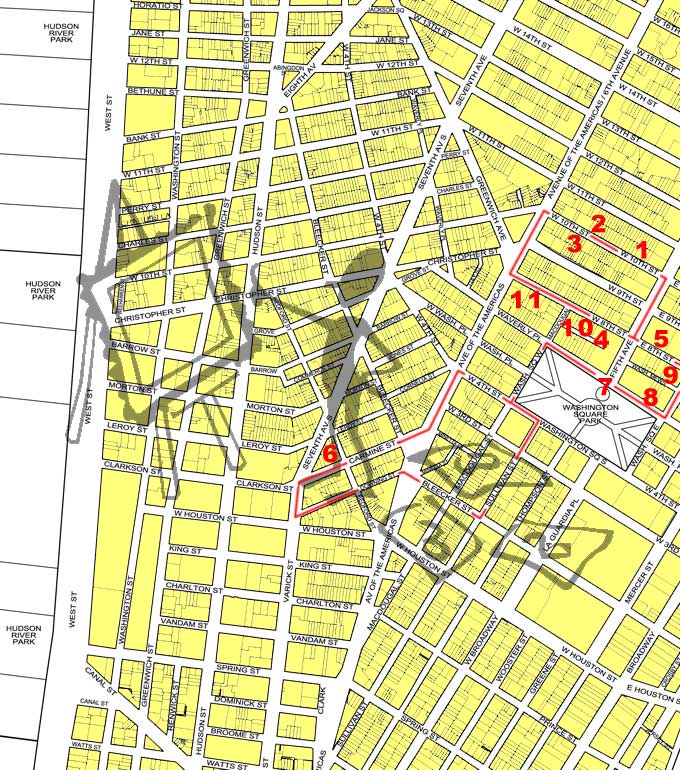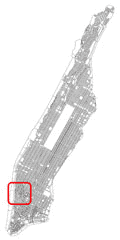|
|
Arists:
The above map illustrates some of the great artists that have produced work within Greenwich Village and SoHo. Indicated above, and described below, are the artists that have either worked in the area. The red line is a suggested walking tour to view the works these artists produced in the Greenwich Village and SoHo area.
|
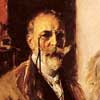 |
1. William Merritt Chase, Tenth Street Studio Building, 15 West Tenth Street (Later 51 West Tenth Street)
William Merritt Chase (November 1, 1849 - October 25, 1916) was an American painter known as an exponent of Impressionism and as a teacher. He also opened a studio in New York in the Tenth Street Studio Building, home to many of the important painters of the day. He was a member of the Tilers, a group of artists and authors, among whom were some of his notable friends: Winslow Homer, Arthur Quartley and Augustus Saint Gaudens. The Tenth Street Studio Building has been described as "the catalyst most responsible for transforming Greenwich Village into a hub for the visual arts."
|
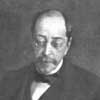 |
2. John La Farge, Studio at 51 West 10th Street
John La Farge (March 31, 1835 - November 14, 1910) was an American painter, stained glass window maker, decorator, and writer. La Farge's inquiring mind led him to experiment with color problems, especially in the medium of stained glass. He succeeded not only in rivaling the gorgeousness of the medieval windows, but in adding new resources by his invention of opalescent glass and his original methods of superimposing and welding his material. Among his many masterpieces are the "Battle Window" at Harvard and the cloisonne "Peacock Window" in the Worcester Art Museum. During his life, he maintained a studio at 51 West 10th Street, in Greenwich Village, which today is part of the site of Eugene Lang College.
|
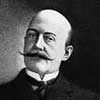 |
3. Winslow Homer, The Tile Club, 58-1/2 West Tenth Street.
Winslow Homer (February 24, 1836 - September 29, 1910) was an American landscape painter and printmaker, best known for his marine subjects. He is considered one of the foremost painters in 19th century America and a preeminent figure in American art.
In 1877, across the street from the Studio Building, local artists formed the Tile Club, an informal association of artists, architects, and musicians who met on a regular basis at No. 58-1/2 West Tenth Street (a small cottage in the garden behind the structure that now houses NYU's Lillian Vernon Center for International Affairs); among the Tilers were the painters Winslow Homer, Edwin Austin Abbey, and John Twachtman; the sculptor Augustus Saint-Gaudens; and the architect Stanford White. In addition to painting on ceramic tiles, the Tilers hosted convivial suppers and sponsored occasional sketching jaunts into the countryside.
|
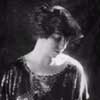 |
4. Gertrude Vanderbilt Whitney, The Whitney Museum of American Art, 8 West 8th Street
Gertrude Vanderbilt Whitney (January 9, 1875 - April 18, 1942) was an American sculptor, art patron and collector, and founder in 1931 of the Whitney Museum of American Art in New York City. In 1907 the sculptor Gertrude Vanderbilt Whitney, one of the city's wealthiest heiresses, took a studio at No. 19 (now No. 17-1/2) MacDougal Alley and began to collect works by contemporary American artists. Especially drawn to modern-life subjects, she concentrated her attention on the work of the Ash Can School, which comprised Henri, Sloan, Glackens, George Luks, and Everett Shinn; in 1908 they joined with three lyrical painters, Maurice Prendergast, Ernest Lawson, and Arthur B. Davies, and exhibited together as The Eight. Whitney soon became one of the foremost champions of contemporary American art, enlarging her focus to include works by Bellows, Edward Hopper, Stuart Davis, and many others. In 1912 she broke through the rear wall of her workrooms into No. 8 West Eighth Street, which she dubbed the Whitney Studio and where she soon began to present exhibitions. Six years later, in a brownstone at No. 147 West Fourth Street, off Washington Square, she established the Whitney Studio Club as a gathering place for artists, furnishing it with a reference library, a billiard table, and a sketching studio. In 1931 the Whitney Studio annexed two neighboring row houses on Eighth Street and was renamed the Whitney Museum of American Art, which remained in the Village until its move uptown in 1954.
|
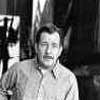 |
5. Franz Kline, The Club 35 East Eighth Street
Franz Kline (May 23, 1910 - May 13, 1962) was an American painter mainly associated with the Abstract Expressionist painters who were centered, geographically, around New York, and temporally, in the 1940s and 1950s; but not limited to that setting. In 1948 a group of artists began to meet at No. 35 East Eighth Street (they later moved down the block to No. 39) for a weekly series of lectures, panel discussions, and conversations that became known as The Club. Members included most of the painters who came to be known as Abstract Expressionists, including Franz Kline, Willem de Kooning, Barnett Newman, Ad Reinhardt, Mark Rothko, and Jackson Pollock. Frnaz Kline had his apartment at 242 West 14th Street.
|
 |
6. Willem de Kooning, Elaine de Kooning Studio, 63 Carmine Street
Willem de Kooning (April 24, 1904 - March 19, 1997) was an abstract expressionist painter, born in Rotterdam, the Netherlands. In the post-World War II era, de Kooning painted in a style that came to be referred to variously as Abstract expressionism, Action painting, and the New York School. Other painters that developed this school of painting include Jackson Pollock, Franz Kline, Arshile Gorky, Mark Rothko, Hans Hofmann, Robert Motherwell, Philip Guston and Clyfford Still among others. In 1926, De Kooning entered the United States as a stowaway on a British freighter, the SS Shelly, to Newport News, Virginia. He then went by ship to Boston, and took a train from Boston to Rhode Island, and eventually settled in Hoboken, New Jersey, where he supported himself as a house painter until moving to a studio in Manhattan in 1927. In 1944, he and his wife moved to a cold-water flat at 63 Carmine Street in Greenwich Village, where Elaine de Kooning worked. Mr. de Kooning then took a separate studio at 88 Fourth Avenue.
|
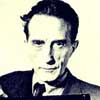 |
7. Marcel Duchamp, Washington Square Arch Proclimation
Marcel Duchamp (28 July 1887 - 2 October 1968) was a French artist whose work is most often associated with the Dadaist and Surrealist movements. Duchamp's output had considerable influence on the development of post-World War I Western art, and whose advice to modern art collectors helped shape the tastes of the Western art world. A playful man, Duchamp prodded thought about artistic processes and art marketing, not so much with words, but with actions such as dubbing a urinal "art" and naming it Fountain. He produced relatively few artworks as he quickly moved through the avant-garde rhythms of his time. Duchamp's financial situation did not improve by selling his works until quite late in life. For years he lived in a modest, $40-a-month apartment in Greenwich Village. In 1914, a group of artists including John Sloan and Marcel Duchamp climbed the spiral staircase within Washington Square Arch to the roof where they lit a bonfire and read a resolution proclaiming the Republic of Greenwich Village, which they toasted with Champagne.
|
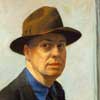 |
8. Edward Hopper, Studio, 3 Washington Square North
Edward Hopper (July 22, 1882 - May 15, 1967) was an American painter and printmaker. While most popularly known for his oil paintings, he was equally proficient as a watercolorist and printmaker in etching. In terms of subject matter, Hopper can be compared to his contemporary, Norman Rockwell. Hopper's work exploits empty spaces, represented by a gas station astride an empty country road and the sharp contrast between the natural light of the sky, moderated by the lush forest, and glaring artificial light coming from inside the gas station. Most of Hopper's paintings have a concentration on the subtle interaction of human beings with their environment and with each other. Like stills for a movie or tableaux in a play, Hopper positions his characters as if they have been captured just before or just after the climax of a scene. Edward Hopper maintained his studio at 3 Washington Square North until his death.
|
 |
9. Jackson Pollock, Apartment 46 East 8th Street, between Mercer and Greene Streets
Jackson Pollock (January 28, 1912 - August 11, 1956) was an influential American painter and a major force in the abstract expressionist movement. He was married to noted abstract painter Lee Krasner. Pollock's most famous paintings were during the "drip period" between 1947 and 1950. He rocketed to popular status following an August 8, 1949 four-page spread in Life Magazine that asked, "Is he the greatest living painter in the United States?" At the peak of his fame, Pollock abruptly abandoned the drip style. In 1935 Jackson Pollock moved into a fifth-floor walk-up apartment just vacated by his brother Charles at 46 East Eighth Street between Greene and Mercer Streets. The rent was $35 per month, which he shared with another brother until 1942, when Jackson's lover, the painter Lee Krasner, moved in.
|
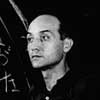 |
10. Isamu Noguchi, Noguchi Studio 33 MacDougal Alley
Isamu Noguchi (November 17, 1904 - December 30, 1988) was a prominent Japanese American artist and landscape architect whose artistic career spanned six decades, from the 1920s onward. Known for his sculpture and public works, Noguchi also designed stage sets for various Martha Graham productions, and several mass-produced lamps and furniture pieces, some of which are still manufactured and sold. Among his furniture work was his collaboration with the Herman Miller company in 1948 when he joined with George Nelson, Paul Lazlo and Charles Eames to produce a catalog containing what is often considered to be the most influential body of modern furniture. In November 1942 Isamu Noguchi returned to New York after six months in a Japanese-American relocation camp, and he moved into a studio at 33 MacDougal Alley in Greenwich Village. Much of Noguchi's work of the Forties was highly influenced by Surrealism, and it was at the MacDougal Alley studio in 1944 that he carved the biomorphic sculptures of inter-locking elements that established his reputation in the growing New York School, and created the self-illuminated sculptures that he called Lunars
|
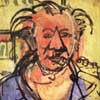 |
11. Hans Hoffman, The Hoffman School of Fine Arts, 52 West 8th Street
Hans Hofmann (March 21, 1880 - February 17, 1966) was a German-born American abstract expressionist painter. He was born in Bavaria on March 21, 1880 the son of Theodor and Franziska Hofmann. In 1932 he immigrated to the United States, where he resided until the end of his life. Hofmann taught at Art Students League in the fall of 1932. The Hans Hofmann School of Fine Arts opened in New York City in the autumn of 1933, operating in several locations before moving to permanent quarters at 52 West 8th Street in 1938.
|
|
|
|
|
|
|
|
|
|
|
|
